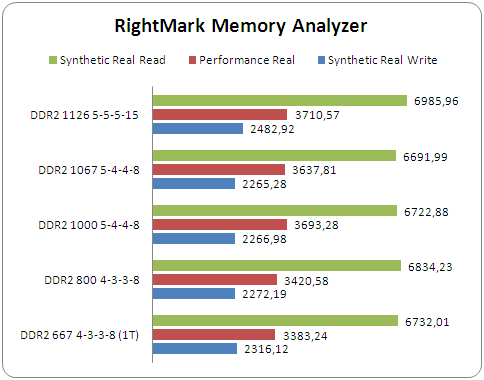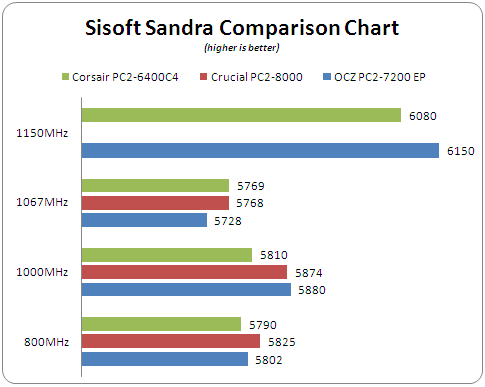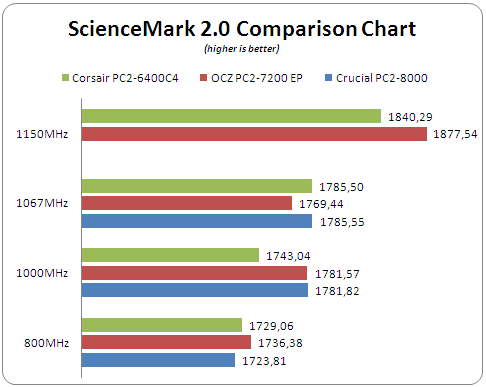1. Introduction
 Corsair is one of the best known memory manufacturers. Corsair has been producing products for all categories of users, from entry level to enthusiast. Today we will test an entry level DDR2 memory product that while keeping its retail price very low, is able to be provide much higher performance than you might have expected.
Corsair is one of the best known memory manufacturers. Corsair has been producing products for all categories of users, from entry level to enthusiast. Today we will test an entry level DDR2 memory product that while keeping its retail price very low, is able to be provide much higher performance than you might have expected.
- Corsair PC2-6400C4 v2.1 Edition
 The Twin2X1024-6400C4 is a 1GByte matched pair of DDR2 SDRAM DIMMs. They delivers outstanding
performance in the latest generation of dual-channel DDR2-based motherboards and have been tested extensively on
multiple DDR2 motherboards to ensure compatibility and performance at their rated speed. This memory has been
verified to operate at 800MHz at the low latencies of 4-4-4-12. The Twin2X1024-6400C4 come with Enhanced
Performance Profiles (EPP), the open standard for performance module SPDs jointly developed by Corsair and
NVIDIA. EPP SPDs on Corsair modules allow users to automatically configure EPP enabled motherboards with
aggressive memory performance settings, for maximum memory and system performance.
The Twin2X1024-6400C4 is a 1GByte matched pair of DDR2 SDRAM DIMMs. They delivers outstanding
performance in the latest generation of dual-channel DDR2-based motherboards and have been tested extensively on
multiple DDR2 motherboards to ensure compatibility and performance at their rated speed. This memory has been
verified to operate at 800MHz at the low latencies of 4-4-4-12. The Twin2X1024-6400C4 come with Enhanced
Performance Profiles (EPP), the open standard for performance module SPDs jointly developed by Corsair and
NVIDIA. EPP SPDs on Corsair modules allow users to automatically configure EPP enabled motherboards with
aggressive memory performance settings, for maximum memory and system performance.

- Features
- 1024 Megabytes of DDR2 memory
- SPD includes Enhanced Performance Profiles (EPP) which automatically overclock to aggressive performance settings
- Implemented using 64Mx8 DDR2 SDRAMS
- 100% tested at 800MHz on high performance DDR2 motherboards
- Legendary Corsair reliability and service
- Lifetime warranty

- Full specifications
- Each module pair is tested together at 800MHz
- Tested and packaged in pairs
- Tested at EPP SPD settings (4-4-4-12) at 2.1V
- SPD programmed at:
- JEDEC standard 5-5-5-18 values at 800MHz
- EPP standard 4-4-4-12-2T, 2.1V values at 800MH
- Retail package
Corsair provided us with the retail package of the XMS2 6400C4 with 2 GB (2x1GB), that cost around €150~190 (+shipping) as found at several online stores. The kit comes in the standard packaging for Corsair memory products.

After opening the retail package, we examined the modules more closely. On both sides there is the Corsair Logo, while on one side there are the product specs:


Let's zoom in on the product specs. We can see a variety of formation, like the full product code, revision (v2.1) and timings.

There are several revisions of 6400C4. If the revision is v1.x it should be based on Micron's D9 chips, a superb product for overclocking. While, if it's 2.x, it's probably Promos. If the revision is 5.x or 6.x, it's probably based on Infineon chipsets. More information about this topic can be found here.
2. Test Setup
In order to test the memory modules, we used the following setup:
- CPU: Intel XE6600 @ 2.4GHz
- Motherboard: eVGA 680i LT
- PSU: OCZ GameXStream GXS600 SLI-Ready
- VGA: MSI 7600GT Silent (stock memory/core timings)
- HDD: WD 800JB
- OS: Windows XP SP2 with all the latest updates installed
While for benchmarking we used:
- Memtest86+ v1.70
- Sisoft Sandra 2007 SP1
- RightMark Memory Analyzer v3.70
- ScienceMark 2.0 Memory Benchmark
- Pov-Ray v3.70 Beta15
- SuperPI XS Mod v1.50
The eVGA 680i LT motherboard offers many possibilities for overclock both memory and CPU, either synced or not. For most of our tests, we set the memory and CPU un-synced and tried to find the best possible, lowest memory timings. Each benchmark had to pass a 30min burn-in test with Memtest86+ v1.70 (DOS), without any producing any errors at all. Furthermore, we tried the Pov-Ray benchmark and Orthos Stability test under Windows to ensure that our system was rock solid. All benchmarks were then run twice and all displayed results are the average of both results.
The SPD, as reported by Everest Ultimate Edition, is only set for 400MHz with 4-4-4-12-2T timings:

In case you are using an EPP Enabled motherboard, those timings will be automatically set by the motherboard.

Lastly, here is the table of FSB and voltages. The product not only performs according to the specs, but with even tighter timings than 4-4-4-12, with of course a higher voltage (2.20). The product is rated at 400MHz, but managed to produce an additional 163MHz, superb performance!

At DDR2 1126MHz, our CPU FSB and RAM were synced (1:1) and we overclocked the CPU up to 2.533GHz

Below are the memory timings as reported by CPU-Z:

3. SiSOFT Sandra - RightMark
 SiSoftware Sandra (the System ANalyser, Diagnostic and Reporting Assistant) is an information & diagnostic utility. It should provide most of the information (including undocumented) you need to know about your hardware, software and other devices whether hardware or software. It works along the lines of other Windows utilities, however it tries to go beyond them and show you more of what's really going on. Giving the user the ability to draw comparisons at both a high and low-level. You can get information about the CPU, chipset, video adapter, ports, printers, sound card, memory, network, Windows internals, AGP, PCI, PCIe, ODBC Connections, USB2, 1394/Firewire, etc.
SiSoftware Sandra (the System ANalyser, Diagnostic and Reporting Assistant) is an information & diagnostic utility. It should provide most of the information (including undocumented) you need to know about your hardware, software and other devices whether hardware or software. It works along the lines of other Windows utilities, however it tries to go beyond them and show you more of what's really going on. Giving the user the ability to draw comparisons at both a high and low-level. You can get information about the CPU, chipset, video adapter, ports, printers, sound card, memory, network, Windows internals, AGP, PCI, PCIe, ODBC Connections, USB2, 1394/Firewire, etc.
Sisoft Sandra offers two tests, un-buffered and buffered. We summed both results and took the average.

 Before this test packet was created there was no proper software for measuring vital system parameters such as CPU/Chipset/RAM providing steady and reliable (reproducible) test results and allowing for changing test parameters in a wide range.
Before this test packet was created there was no proper software for measuring vital system parameters such as CPU/Chipset/RAM providing steady and reliable (reproducible) test results and allowing for changing test parameters in a wide range.
Vital low-level system characteristics include latency and real RAM bandwidth, average/minimal latency of different cache levels and its associativity, real L1-L2 cache bandwidth and TLB levels specs. Besides, these aspects are usually not paid sufficient attention in product technical documentation (CPU or chipset). Such test suite, which combines a good deal of subsets aimed at measuring objective system characteristics, is a must have for estimating crucial objective platform parameters.
RightMark offers a variety of test results, including read and write performance with synthetic and performance tests:

4. Science Mark - SuperPi
Science Mark 2.0 is an attempt to put the truth behind benchmarking. In an attempt to model real world demands and performance, SM2 is a suite of high-performance benchmarks that realistically stress system performance without architectural bias. Science Mark 2.0 is comprised of 7 benchmarks, each of which measures a different aspect of real world system performance.

SuperPI has become an utility to benchmark modern systems. In August 1995, the calculation of pi up to 4,294,960,000 decimal digits was succeeded by using a supercomputer at the University of Tokyo. The program was written by D.Takahashi and he collaborated with Dr. Y.Kanada at the computer center, the University of Tokyo. This record-breaking program was ported to the personal computer environment such as Windows NT and Windows 95, and called Super PI.

The software offers up to 32M calculations of PI numbers. For all memory settings, we tested only up to 2M calculations.

5. Comparison Results
In order to compare the performance of the Corsair XMS2 PC2-6400C4, we used two higher rated memory products from Crucial and OCZ.



In all tests, the Corsair PC2-6400C4 was somewhat slower than the other two products, but keep in mind that the other two products cost almost twice as much!
6. Conclusion
 The Corsair XMS PC2-6400C4 comes to bridge a gap for many users with its low price while still providing very good overclocking capabilities. This product includes EPP profiles for 400MHz with 4-4-4-12-2T timings. So, if you have an EPP enabled motherboard, you can have the highest possible performance with lower timings.
The Corsair XMS PC2-6400C4 comes to bridge a gap for many users with its low price while still providing very good overclocking capabilities. This product includes EPP profiles for 400MHz with 4-4-4-12-2T timings. So, if you have an EPP enabled motherboard, you can have the highest possible performance with lower timings.

According to our tests, the memory reached 563MHz with a voltage of 2.3V! That's 163MHz higher than what Corsair rates the product at. It's quite possible that with higher memory voltages, you can boost more MHz, but this is not suggested. With lower speeds, you can have 1T at 333MHz, but this only applies to Nvidia 680i chipset motherboards.

Ending our presentation, we are very satisfied with the Corsair PC2-6400C4 memory series. The product does work as advertised, and with the proper motherboard and memory voltage, can provide an additional 163Mhz for your overclocking needs. The retail price is really "low", at around €150~190.
